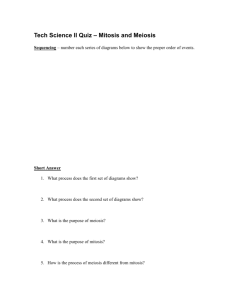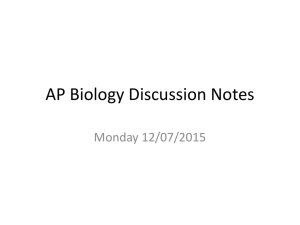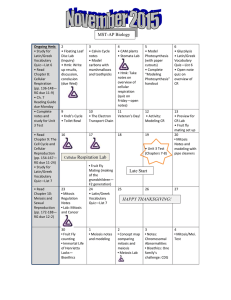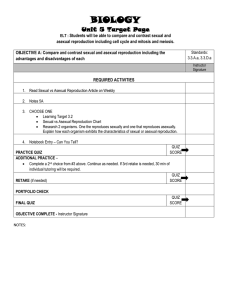AP BIO Unit 3: Cells
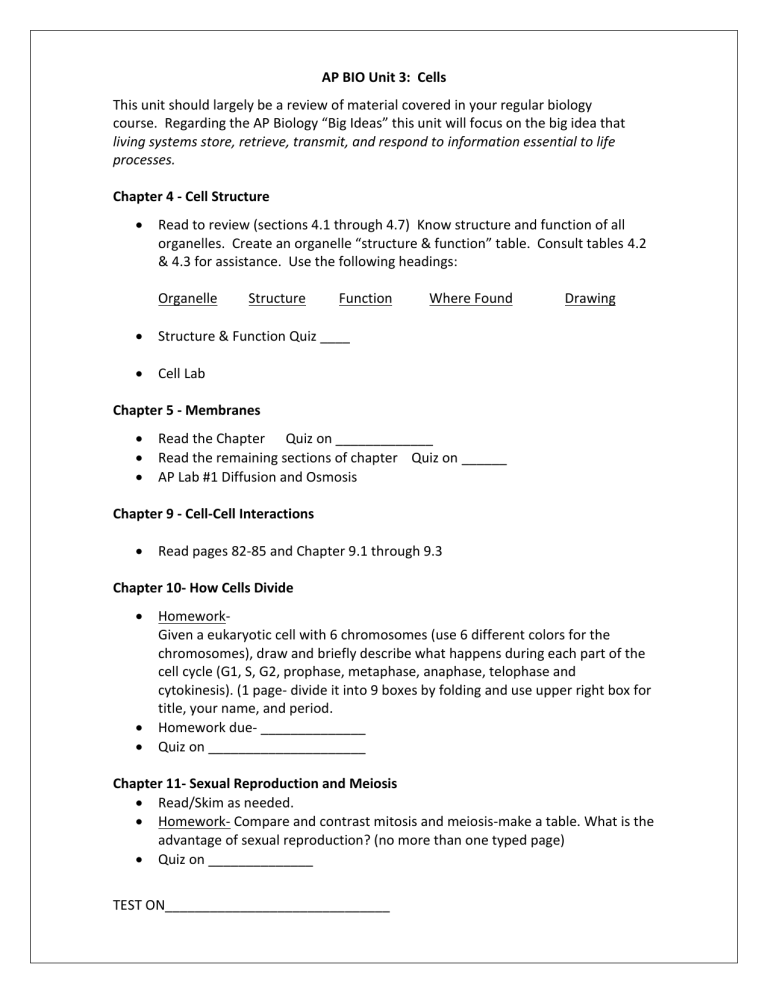
AP BIO Unit 3: Cells
This unit should largely be a review of material covered in your regular biology course. Regarding the AP Biology “Big Ideas” this unit will focus on the big idea that living systems store, retrieve, transmit, and respond to information essential to life processes.
Chapter 4 - Cell Structure
Read to review (sections 4.1 through 4.7) Know structure and function of all organelles. Create an organelle “structure & function” table. Consult tables 4.2
& 4.3 for assistance. Use the following headings:
Organelle Structure Function Where Found Drawing
Structure & Function Quiz ____
Cell Lab
Chapter 5 - Membranes
Read the Chapter Quiz on _____________
Read the remaining sections of chapter Quiz on ______
AP Lab #1 Diffusion and Osmosis
Chapter 9 - Cell-Cell Interactions
Read pages 82-85 and Chapter 9.1 through 9.3
Chapter 10- How Cells Divide
Homework-
Given a eukaryotic cell with 6 chromosomes (use 6 different colors for the chromosomes), draw and briefly describe what happens during each part of the cell cycle (G1, S, G2, prophase, metaphase, anaphase, telophase and cytokinesis). (1 page- divide it into 9 boxes by folding and use upper right box for title, your name, and period.
Homework due- ______________
Quiz on _____________________
Chapter 11- Sexual Reproduction and Meiosis
Read/Skim as needed.
Homework- Compare and contrast mitosis and meiosis-make a table. What is the advantage of sexual reproduction? (no more than one typed page)
Quiz on ______________
TEST ON______________________________
For this first unit, as a review you will create a crossword puzzles.
Chapter 4
Importance of surface area to volume ratio (Why is it beneficial for cells to be smaller)
Cell theory
Parts of a prokaryote (bacterium)
Difference between flagella and cilia
Endosymbiosis
(The structure and function of all cell parts)
Chapter 5
Fluid mosaic model
Kinds of Membrane Proteins
Simple diffusion
Facilitated diffusion (3 characteristics)
Aquaporins
Osmotic pressure / Turgor pressure
Water potential
Bulk Transport (several types)
Active Transport: Sodium-Potassium Pump
Coupled Transport : know the basic gist
Make sure that you understand the concepts covered in the formal lab on diffusion/osmosis
Chapter 9
Direct, Paracrine, Endocrine, and Synaptic Signaling
Signal Transduction Pathway
Protein Kinase
MHC proteins
Types of receptors
Chapter 10
Prokaryotic cell division
Chromosome structure
Histones
Cell cycle
Differences in plant cell and animal cell mitosis
The organelles involved in mitosis
Cell cycle regulation: Cdks, Growth factors, p53, Tumor-suppression
(mitosis phases)
Chapter 11
Synapsis
Crossing over
Meiosis
(meiosis phases)
The advantages of sexual reproduction


